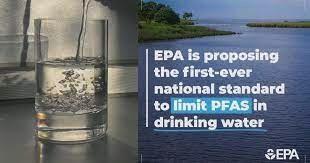The U. S. Environmental Protection Agency (EPA) has proposed a national drinking water standard covering six per-polyfluoroalkyl compounds generally referred to as PFAS (“forever chemicals”). The proposal would require regulation of two of the chemicals in the group to four parts per trillion with a limit over the mix of four others in the group. In 2016, based on available information at the time, the recommended PFAS concentration in drinking water was set at 70 parts per trillion. Operators of water systems will be required to determine levels and take corrective measures to reduce contamination.

This action follows emerging evidence that PFAS compounds are deleterious to health and that imposing stricter upper limits would eliminate health hazards. Accumulation of PFAS in liver and kidney tissues can predispose to cancer, obesity, elevated blood cholesterol and decreased fertility.
Since 1940, PFAS compounds have been incorporated in water repellant clothing, furniture, carpets, non-stick pans, paints, cosmetics and fire-fighting foam. Two of the most toxic compounds were phased out of production a decade ago, according to the American Chemistry. Council. Predictably, this industry questions the scientific justification used by the EPA to set levels.

Currently ten U. S. states in the Northeast and in Michigan and Wisconsin have limits on PFAS in drinking water. Despite reduced use of these compounds, their persistence in the environment, including soil and water, will represent a problem for centuries to come.
The EPA proposal will be subject to public comment and if adopted, public water systems will have three years from the date of the regulation to comply. There will be considerable expense to comply with the proposed standard. Extesive litigation is expected that will delay resolution of an accepted level.